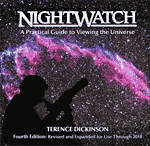|
1
|
Moon near Mars (evening sky) at 7h UT. Mag. +0.0.
|
|
4
|
Moon near Spica (evening sky) at 19h UT.
|
|
4
|
Moon near Saturn (evening sky) at 20h UT. Mag. +0.3.
|
|
5
|
Eta Aquarid meteor shower peaks. Active from April 19 to May 28. Associated with Comet Halley. Very fast, bright meteors, up to 10-20 per hour. Favors skywatchers in the tropics and southern hemisphere observing a few hours before dawn.
Unfavorable in 2012 due to bright moonlight.
• The Eta Aquarids (Gary Kronk)
• Meteor Shower Calendar (April to June) (IMO)
|
|
6
|
Full Moon at 3:35 UT. Largest this year.
• Full Moon Names (Wikipedia)
|
|
6
|
Moon at perigee (closest to Earth) at 4h UT (356,955 km; 33.5'). Nearest in 2012. Occurs very close to Full Moon. Very high tides expected.
• Earth-Moon Distance vs Full Moon (Geert Barentsen)
|
|
7
|
Moon near Antares (morning sky) at 18h UT.
|
|
12
|
Last Quarter Moon at 21:47 UT.
|
|
13
|
Jupiter at conjunction with the Sun at 13h UT. Passes into the morning sky (not visible).
|
|
19
|
Moon at apogee (farthest from Earth) at 16h UT (distance 406,448 km; angular size 29.4').
|
|
20
|
New Moon at 23:47 UT. Start of lunation 1106.
• Lunation Number (Wikipedia)
|
|
20
|
Annular Solar Eclipse from 22:00 to 1:30 UT (5/21). Annular (ring-like) eclipse visible on a narrow path from southern coast of China (sunrise), across parts of Japan (including Tokyo), across the North Pacific, before making landfall
near the California-Oregon coast (22° above horizon at 6:24 PDT), then across the Grand Canyon, Bryce and Zion National Parks to Albuquerque (5° above horizon), before sunset near Lubbock in Western Texas. The partial phase is visible
across Asia, the vast Pacific Ocean, and North America.
• Annular Solar Eclipse of 2012 May 20 (NASA/Google Map)
• Annular Solar Eclipse of 2012 May 20 (NASA/PDF)
• Eclipses in 2012 (NASA inc Maps & Tables)
• May 20th's Annular Eclipse of the Sun (Sky & Telescope)
|
|
22
|
Moon near Venus (21° from Sun, evening sky) at 22h UT. Mag. -4.5. A telescope will show Venus as a thin crescent.
|
|
26
|
Moon near Beehive cluster (M44) (evening sky) at 12h UT.
• Beehive Star Cluster (M44) (Wikipedia)
|
|
27
|
Mercury at superior conjunction with the Sun at 11h UT. The planet passes into the evening sky.
|
|
28
|
Moon near Regulus (evening sky) at 5h UT.
|
|
28
|
First Quarter Moon at 20:15 UT.
|
|
All times Universal Time (UT). USA Eastern Daylight Time = UT - 4 hours.
|






